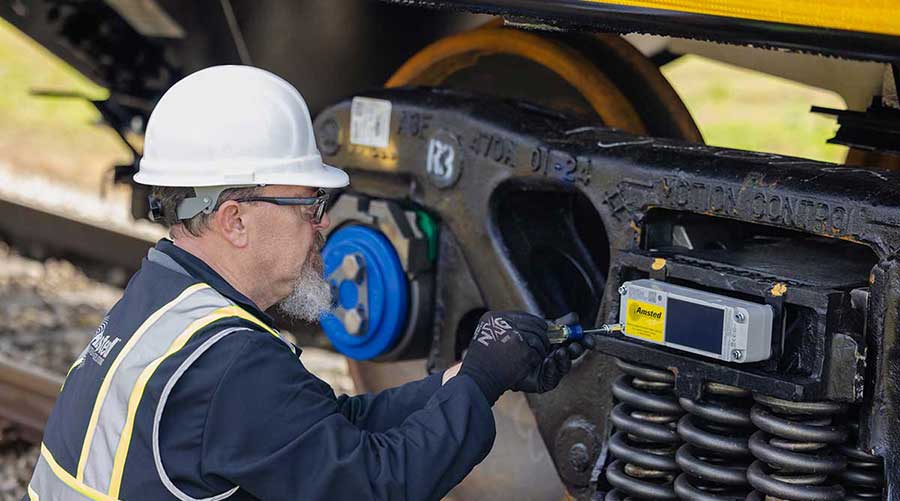Stay updated on news, articles and information for the rail industry
October 2008
Rail News: Rail Industry Trends
On diversions and matters of the regulatory heart (Pat Foran, Context, October 2008)
 At a time when North American railroads would seem to be poised to capture freight from the highways, they actually might be losing it. It isn’t a service thing — rail service has been good, arguably really good, of late, according to a survey we conducted in August in conjunction with the National Industrial Transportation League (NITL). Higher rail rates are driving some shippers to divert to truck, they told us.
At a time when North American railroads would seem to be poised to capture freight from the highways, they actually might be losing it. It isn’t a service thing — rail service has been good, arguably really good, of late, according to a survey we conducted in August in conjunction with the National Industrial Transportation League (NITL). Higher rail rates are driving some shippers to divert to truck, they told us.
Now, this survey was an informal one, and the sampling was small. Our story characterizing the results contains little in the form of a rail response; aside from reasserting their right in the Land of The Invisible Hand to charge for the value of their service, railroads generally decline to talk about anything involving customers/rates, and our experience was no different. But given rails’ flat-at-best traffic volumes despite the mode’s fuel-cost advantage (whatever your take on the fuel surcharge flap) and the truckers’ assortment of woes, something’s happening here.
In some instances, roads could be pricing themselves out of the market because they don’t want certain pieces of business, as some shippers believe (and as some rail execs have acknowledged). Ultimately, “rates,” per se, aren’t necessarily the issue — the total transportation cost is, shippers tell us, citing instances where the rail rate may be high but the overall cost isn’t due to process efficiencies. That said, many shippers would prefer to move more freight by rail. What would railroads need to do to get a piece of that business (if they’re so inclined)? It’s a question we’ll be kicking around in the coming months.
There’s been another consequence of the higher-transportation cost climate, shippers told us via survey and follow-up interviews: Higher rates are prompting some rail shippers to put more energy behind the perennial call for more regulatory action. No surprise there. But I’m not sure an energy injection is going to make much of a difference. For one thing, members of NITL, which represents the interests of 600-plus shippers, aren’t in lockstep on this one. Although more appear to be pushing for the current “rail competition” bills, others clearly side with the “no re-reg” rail lobby. There isn’t a unified shipper front (has there ever been?) when it comes to matters of the regulatory heart — just as there isn’t one in Congress, as we saw last month during the epic struggle to come to terms on a financial bailout plan.
On Oct. 1, the U.S. Senate approved a $700 billion package; the House was expected to vote on it on Oct. 3, or after this issue went to press. Meanwhile, the credit markets remained virtually frozen at September’s end. Heating up, though, were debates on the implications for regulatory matters in other realms, rail included. Might it contribute to a climate that would make measures like The Railroad Competition and Service Improvement Act of 2007 (“re-reg” to the rails) more likely to pass? Less likely? Could the bailout send transportation issues back to the back burner?
The back-burnering seems likely, at least for the near term. Considering the progress transportation stakeholders have made to get transportation in general, and rail in particular, to register on the urgency meter in D.C., that’d be unfortunate. We’ll see where we are in early ’09. In the meantime, we’ll track this exceedingly fluid story as it unfolds.
At credit-crisis time, credit where it’s due
If you were out at all on the rail-industry conference and trade-show circuit last month, you couldn’t miss it: Credit crisis talk dominated the discussions. It was top of mind at the REMSA World Rail Expo and AREMA Annual Conference in Salt Lake City, the RSI Global Railway Tech/CMA in Chicago and Germany’s InnoTrans (or so I was told), as well as at our own RailTrends summit in New York City (more on how that event went next month).
There’s no question the credit crisis will affect rail investment. I’m sure it already has. But I was struck by the optimism that pretty much ruled the day during the conversations I had or sat in on. Despite all the reasons they have to feel skittish — and who knows how they’ll feel by the time these words are circulating — rail folks (carriers and the people who supply them) felt good about the industry’s ’09 prospects. Not one of the players or observers I talked with (or heard from via other sources) reported any signs of freaking — the fundamentals, they said, still hold when it comes to the future of North American freight and passenger rail.
Thinking longer term during these most interesting of times, despite all the uncertainty? Imagine that. Chalk up another one for the power of positive thinking that the very real Rail Renaissance continues to engender. And give credit where it’s due to the rail folks for playing the faith card during this very real credit crisis. 
 |
Keywords
Browse articles on rail shipper rail customer NITL National Industrial Transportation League rail serviceContact Progressive Railroading editorial staff.


 2025 MOW Spending Report: Passenger-rail programs
2025 MOW Spending Report: Passenger-rail programs
 Gardner steps down as Amtrak CEO
Gardner steps down as Amtrak CEO
 Guest comment: Oliver Wyman’s David Hunt
Guest comment: Oliver Wyman’s David Hunt
 Women of Influence in Rail eBook
Women of Influence in Rail eBook
 railPrime
railPrime





